 Three years ago, in "Torture: A War Crime Then And Now", I described the legal principles that led to a conviction and life sentences of those who were responsible for my father's torture during WWII. I argued that, if applied now, the architects of the Bush/Cheney torture regime would be languishing in prison.
Three years ago, in "Torture: A War Crime Then And Now", I described the legal principles that led to a conviction and life sentences of those who were responsible for my father's torture during WWII. I argued that, if applied now, the architects of the Bush/Cheney torture regime would be languishing in prison.
While it is troubling that none of those individuals were prosecuted for war crimes, it is beyond disturbing that President Donald J. Trump has seen fit to nominate Gina Haspel, the current Deputy Director of the Central Intelligence Agency, to be the CIA's next chief.
Given that Haspel not only oversaw torture at a CIA "black site" in Thailand but was also later involved in the destruction of videotaped evidence of CIA torture, such as the water-boarding of Abu Zubaydah 83 times in a single month, it seems appropriate to revisit several segments of that previous article, which had been initially published in response to a long, very well researched U.S. Senate Intelligence Committee report on U.S. torture...
U.S. Senate Torture Report
 As I wrote in 2014, if there is a downside to the executive summary of the 2014 U.S. Senate Torture Report [PDF], it can be found in the extraordinary lengths to which it goes to demonstrate a long-established fact: Torture is ineffective as a means for extracting actionable intelligence.
As I wrote in 2014, if there is a downside to the executive summary of the 2014 U.S. Senate Torture Report [PDF], it can be found in the extraordinary lengths to which it goes to demonstrate a long-established fact: Torture is ineffective as a means for extracting actionable intelligence.
Emboldened by that focus, U.C. Berkeley Law Prof. John Yoo authored a response to the Senate Torture Report by way of a, Los Angeles Times op-ed. In 2002, while serving as the Deputy Assistant U.S. Attorney General, Yoo authored a memo that green-lighted CIA torture following the 9/11 attacks. The memo, according to UC-Irvine's renowned constitutional law professor Erwin Chemerinsky, should serve as the basis for the prosecution of Yoo for war crimes. Shielded by the Obama/Holder Dept. of Justice's refusal to prosecute, Yoo shamelessly argued in his editorial that the then-newly released Senate Torture Report had shifted [emphasis added] "the debate beyond legality to effectiveness."
The issue of torture's "effectiveness" is not and never has been an appropriate subject for "debate." Robert Colville, the U.N. High Commissioner for Human Rights makes that clear in referencing the U.N. Convention against Torture, an international human rights treaty to which the U.S. is a signatory. "Torture is prohibited absolutely, in all circumstances, at any time," he explains in regard to the treaty signed by President Ronald Reagan. "It cannot be practiced in war, in peace, during emergencies, during internal instability, any circumstances whatsoever."
Those legal proscriptions apply not only to those who carry out torture but also, under the principle of "command responsibility," to high level officials who facilitate or fail to prevent torture by their subordinates.
As I revealed in my five-part series on the History of CIA Torture: Unraveling the Web of Deceit back in 2009, for me, torture is exceedingly personal. In late 1942 my father, James R. Canning, was waterboarded at Shanghai's Bridge House, an infamous torture chamber --- something that entailed a frightening, traumatic and "exquisitely painful," six-hour ordeal. He eventually signed a "false confession" stating that he was a British agent, even though he knew it wasn't true and even though he believed at that moment he was signing his own death warrant.
This Partial Trial Transcript [PDF] includes my father's testimony at the 1948 Hong Kong War Crimes Trials. It exposes the hypocrisy in the Obama/Holder DoJ's failure to apply the same ("command responsibility") legal standard to Yoo, former Vice President Dick Cheney --- who now proudly declares "I'd do it again in a minute!" --- and other high-level, Bush administration officials.
In 1948, that "command responsibility" standard was used to convict Lt. General Eiichi Kinoshida, who received a life sentence even though there was no evidence he personally participated in torture.
If we are indeed, as proclaimed by Sen. Diane Feinstein (D-CA) in her Forward to the Senate Torture Report, a "nation of laws," President Obama would have heeded calls made at the time of the report's release, by the ACLU, Human Rights Watch and even by The New York Times to appoint a special prosecutor who would investigate the crimes the CIA allegedly committed at the behest of Cheney et al --- crimes that appear as heinous and more so than those that were inflicted upon my father and his fellow civilian inmates during World War II.
Alas, Obama never heeded those calls and there was never any accountability for those horrific U.S. war crimes.
Worse than Bridge House?
 No doubt many readers will find the partial trial transcript of the 1948 war crimes trial disturbing. The conditions it depicts at Shanghai's Bridge House include the crowding of as many as 19 prisoners in a filthy, insect and vermin infested 19' x 11' cell with inadequately fed and, especially during cold winter months, inadequately clothed, civilian prisoners, left with nothing more than a single bucket in the same cell to relieve themselves.
No doubt many readers will find the partial trial transcript of the 1948 war crimes trial disturbing. The conditions it depicts at Shanghai's Bridge House include the crowding of as many as 19 prisoners in a filthy, insect and vermin infested 19' x 11' cell with inadequately fed and, especially during cold winter months, inadequately clothed, civilian prisoners, left with nothing more than a single bucket in the same cell to relieve themselves.
As described in the partial transcript, prisoners at Bridge House were subjected to a variety of tortures, including electric shock treatments, prolonged beatings, stringing prisoners up by their thumbs and waterboarding in order to "make their bodies confess." The transcript reveals that at least two Bridge House detainees died while in custody of the Japanese military, including a Chinese man who was deliberately deprived of food and water.
Despite a number of horrific descriptions of similar techniques carried out by the CIA against many prisoners after 9/11, (many of whom turned out to be completely innocent of any crime whatsoever), the Senate's 499-page executive summary might appear relatively sterile to the uninformed. However, it must be kept in mind that the Senate's more than 6,700-page full report remains classified. The CIA destroyed videotapes that could potentially show that CIA waterboarding was as brutal as my father's 6-hour ordeal in which he repeatedly lost consciousness, only to awaken to observe one of the Japanese soldiers rolling back-and-forth on his stomach in order to extract water that had been forced up his mouth and nostrils and into his lungs.
Importantly, where the war crimes trial after WWII exposes the brutality of torture from the point of view of the tortured, the Senate Report, a compilation of more than 6 million pages of internal CIA documentation, reveals only the point of view of the torturers themselves.
The methods applied by the Japanese Kempetai at Bridge House were crude in comparison to the CIA's application of the science of torture, which, as discussed in Part II of our five-part series on the History of CIA torture, quoting Prof. Alfred McCoy, was the product of a "Manhattan Project of the mind" conducted by the CIA between 1950-1962 at a cost of more than $1 billion/year.
While the Bridge House prisoners suffered tremendously, at least they had one-another in that horrific 19'x11' cell. By contrast, the Senate Torture Report reveals a systematic application of the CIA's 1963 KUBARK torture manual. CIA detainee/victims, in the years following on 9/11, were forced to suffer prolonged isolation and prolonged sleep and sensory deprivation coupled with the Soviet KGB technique of self-inflicted pain brought on by being forced to remain in inhumane stress positions for extended periods. Between the 83 times he was water-boarded, Abu Zubaydah was kept inside a coffin-like box.
The Senate Torture Report documents:
In one instance, the victim was "chained to a wall in the standing position for 17 days." Other victims were stripped naked, doused with or submerged in freezing water, shackled and deprived of light. And, unlike the Bridge House prisoners, the victims of CIA torture were subjected to what amounts to rape by a foreign object in the form of "rectal hydration" tubes.
Accountability
 Comparative analysis suggests that the most disturbing gap between then (post-WWII) and now (post-9/11) can be found within the concept of accountability.
Comparative analysis suggests that the most disturbing gap between then (post-WWII) and now (post-9/11) can be found within the concept of accountability.
As explained by Prof. Suzannah Linton, a British law professor who compiled the Hong Kong War Crimes Trial Collection, the question of legal accountability for war crimes committed during World War II was first addressed by President Franklin D. Roosevelt in an Oct. 7, 1942 declaration. The United Nations War Crimes Commission began collecting lists of criminals in 1943 and a "Sub-Commission" to investigate Japanese war crimes was created in May 1944.
While due process was afforded when the victorious World War II allies conducted the Nuremberg and Hong Kong War Crimes Trials, the legal basis for doing so was perhaps more tenuous in 1948 than it is now. Japan, for example, was not a party to the U.N. War Crimes Commission when that U.N. Commission began collecting lists of criminals in 1943. By contrast, the United States is a party to the 1984 United Nations Convention Against Torture and Other Cruel, Inhumane or Degrading Treatment, which strictly bars the horrific tactics described above.
Under that treaty, and the 1949 Geneva Convention, the U.S. has a legal obligation to either investigate, and when warranted, prosecute those suspected of torture or to extradite every person reasonably accused of having legal responsibility for torture to other nations who, in lieu of our doing so, are willing to carry out the prosecution required by signatories of the treaty.
While Feinstein praised Obama for ordering an immediate end to CIA torture, as we explained in "Fixing the Facts and Legal Opinions Around the Torture Policy", President Obama's use of sophistries in which, out of political expediency, he equated law enforcement with "retribution", amounted to a violation of his solemn oath to see that the laws of the United States are faithfully executed. That oath applies to our treaty obligations under the "Supremecy Clause" of the U.S. Constitution (Article 6) declaring that all such treaties to which the U.S. are signatories "shall be the supreme law of the land".
If ours is still a nation of laws, Gina Haspel would now be languishing in prison. Instead, she is President Trump's nominee to be the next Director of the CIA.
• U.S. Senate Torture Report (executive summary, released 12/9/2014) [PDF]
• Shanghai Kempetai Bridge House Trial (partial transcript, James R. Canning, 12/23/1948) [PDF]
 Ernest A. Canning is a retired attorney, author, Vietnam Veteran (4th Infantry, Central Highlands 1968) and a Senior Advisor to Veterans For Bernie. He has been a member of the California state bar since 1977. In addition to a juris doctor, he has received both undergraduate and graduate degrees in political science. Follow him on twitter: @cann4ing
Ernest A. Canning is a retired attorney, author, Vietnam Veteran (4th Infantry, Central Highlands 1968) and a Senior Advisor to Veterans For Bernie. He has been a member of the California state bar since 1977. In addition to a juris doctor, he has received both undergraduate and graduate degrees in political science. Follow him on twitter: @cann4ing


 Sunday 'Now Hoarding' Toons
Sunday 'Now Hoarding' Toons Mad World:
Mad World: 'Green News Report' 5/15/25
'Green News Report' 5/15/25
 Plane Corruption and the Future of the DOJ: 'BradCast' 5/14/25
Plane Corruption and the Future of the DOJ: 'BradCast' 5/14/25 'Deeply Evil': GOP Proposes Largest Medicaid Cuts in History: 'BradCast' 5/13/25
'Deeply Evil': GOP Proposes Largest Medicaid Cuts in History: 'BradCast' 5/13/25 'Green News Report' 5/13/25
'Green News Report' 5/13/25 And Then They Came for the Mayors...: 'BradCast' 5/12/25
And Then They Came for the Mayors...: 'BradCast' 5/12/25 Sunday 'New Guy, Old Guy' Toons
Sunday 'New Guy, Old Guy' Toons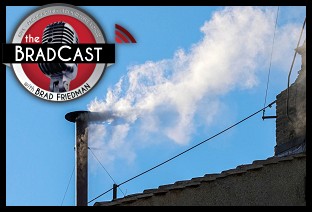 Blowing Smoke. At the Vatican and White House: 'BradCast' 5/8/25
Blowing Smoke. At the Vatican and White House: 'BradCast' 5/8/25 'Green News Report' 5/8/25
'Green News Report' 5/8/25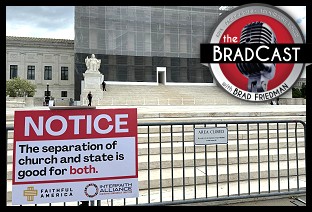 SCOTUS Weighs Public Funding of Religious Schools: 'BradCast' 5/7/25
SCOTUS Weighs Public Funding of Religious Schools: 'BradCast' 5/7/25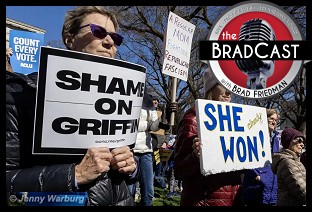 Trump Judge Blocks NC GOP Theft of 2024 Supreme Court Seat: 'BradCast' 5/6/25
Trump Judge Blocks NC GOP Theft of 2024 Supreme Court Seat: 'BradCast' 5/6/25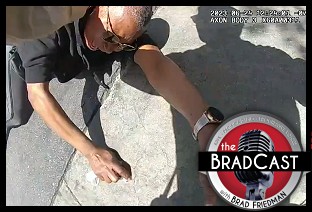 Prosecutors Quit After U.S Attny Strikes Deal With Felon Cop: 'BradCast' 5/5/25
Prosecutors Quit After U.S Attny Strikes Deal With Felon Cop: 'BradCast' 5/5/25 Trump Losing Streak Continues into SECOND Hundred Days: 'BradCast' 5/1/25
Trump Losing Streak Continues into SECOND Hundred Days: 'BradCast' 5/1/25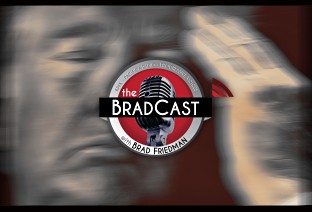 100 Daze (w/ Digby and Driftglass): 'BradCast' 4/30/25
100 Daze (w/ Digby and Driftglass): 'BradCast' 4/30/25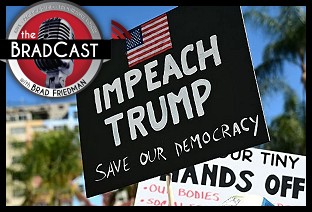 Campaign to 'Impeach Trump Again' Gains Fresh Momentum: 'BradCast' 4/29/25
Campaign to 'Impeach Trump Again' Gains Fresh Momentum: 'BradCast' 4/29/25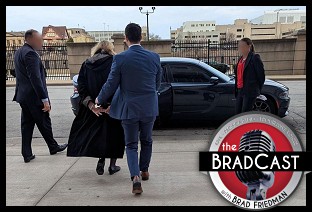 And Then They Came for the Judges...: 'BradCast' 4/28/25
And Then They Came for the Judges...: 'BradCast' 4/28/25 Trump EPA Guts Enviro Justice Office: 'BradCast' 4/24/25
Trump EPA Guts Enviro Justice Office: 'BradCast' 4/24/25
 VA GOP VOTER REG FRAUDSTER OFF HOOK
VA GOP VOTER REG FRAUDSTER OFF HOOK Criminal GOP Voter Registration Fraud Probe Expanding in VA
Criminal GOP Voter Registration Fraud Probe Expanding in VA DOJ PROBE SOUGHT AFTER VA ARREST
DOJ PROBE SOUGHT AFTER VA ARREST Arrest in VA: GOP Voter Reg Scandal Widens
Arrest in VA: GOP Voter Reg Scandal Widens ALL TOGETHER: ROVE, SPROUL, KOCHS, RNC
ALL TOGETHER: ROVE, SPROUL, KOCHS, RNC LATimes: RNC's 'Fired' Sproul Working for Repubs in 'as Many as 30 States'
LATimes: RNC's 'Fired' Sproul Working for Repubs in 'as Many as 30 States' 'Fired' Sproul Group 'Cloned', Still Working for Republicans in At Least 10 States
'Fired' Sproul Group 'Cloned', Still Working for Republicans in At Least 10 States FINALLY: FOX ON GOP REG FRAUD SCANDAL
FINALLY: FOX ON GOP REG FRAUD SCANDAL COLORADO FOLLOWS FLORIDA WITH GOP CRIMINAL INVESTIGATION
COLORADO FOLLOWS FLORIDA WITH GOP CRIMINAL INVESTIGATION CRIMINAL PROBE LAUNCHED INTO GOP VOTER REGISTRATION FRAUD SCANDAL IN FL
CRIMINAL PROBE LAUNCHED INTO GOP VOTER REGISTRATION FRAUD SCANDAL IN FL Brad Breaks PA Photo ID & GOP Registration Fraud Scandal News on Hartmann TV
Brad Breaks PA Photo ID & GOP Registration Fraud Scandal News on Hartmann TV  CAUGHT ON TAPE: COORDINATED NATIONWIDE GOP VOTER REG SCAM
CAUGHT ON TAPE: COORDINATED NATIONWIDE GOP VOTER REG SCAM CRIMINAL ELECTION FRAUD COMPLAINT FILED AGAINST GOP 'FRAUD' FIRM
CRIMINAL ELECTION FRAUD COMPLAINT FILED AGAINST GOP 'FRAUD' FIRM RICK SCOTT GETS ROLLED IN GOP REGISTRATION FRAUD SCANDAL
RICK SCOTT GETS ROLLED IN GOP REGISTRATION FRAUD SCANDAL VIDEO: Brad Breaks GOP Reg Fraud Scandal on Hartmann TV
VIDEO: Brad Breaks GOP Reg Fraud Scandal on Hartmann TV RNC FIRES NATIONAL VOTER REGISTRATION FIRM FOR FRAUD
RNC FIRES NATIONAL VOTER REGISTRATION FIRM FOR FRAUD EXCLUSIVE: Intvw w/ FL Official Who First Discovered GOP Reg Fraud
EXCLUSIVE: Intvw w/ FL Official Who First Discovered GOP Reg Fraud GOP REGISTRATION FRAUD FOUND IN FL
GOP REGISTRATION FRAUD FOUND IN FL

































